
A 9-Part Competitive Analysis Framework for Event Organisers
One of the biggest wastes of energy in modern business is being jealous of your competitors’ success.
In this post, I want to explore different ways that you can get inspired by those successes to fuel your own strategies, and spend that energy more productively. These options come from a place of being proactive about what you can do, instead of just brewing an internal sense of rivalry that neither benefits you nor your event attendees.
The 9 areas of this competitive analysis framework that you can try just by looking at your competitors’ sites are these:
- Organic Social Media; what channels do your shared audiences prefer?
- Paid Social Media; where are the competition spending their money?
- SEM & Display Ads; what are your competitors pushing?
- Content & SEO; what search terms are your attendees using?
- Community Building; how do you keep attendees excited?
- Web Technologies; what tools are making your competitors’ lives easier?
- Tickets; how are your competitors selling their event?
- Lead Generation; how are your competitors gathering interest?
- Sponsorship; how are your competitors funding their events?
But let’s go into a little more detail…
Marketing Tactics
What tactics are they using?
If you’ve ever dipped your toes into the world of marketing, you’ll know that one of the biggest challenges is finding the right channel to put the word out about your conference. Figuring out where your ideal attendees search for information is a process that requires a lot of attention and research. And, if this is your first conference or larger scale event, that task can be a daunting one.
For inspiration, you can take a look at some of your competitors’ sites to see what channels they’ve had success with. But, where to start?
1) Organic Social Media
The Takeaway:
- Which social channels you should experiment with first to build an audience for your event.
Social channel buttons usually sit above the navigation bar, in a burger menu, or at the bottom of the footer on websites. Clicking through these links and taking a look at your competitors’ different follower counts across their accounts can help you make an educated guess as to where your attendees and fans are most engaged.
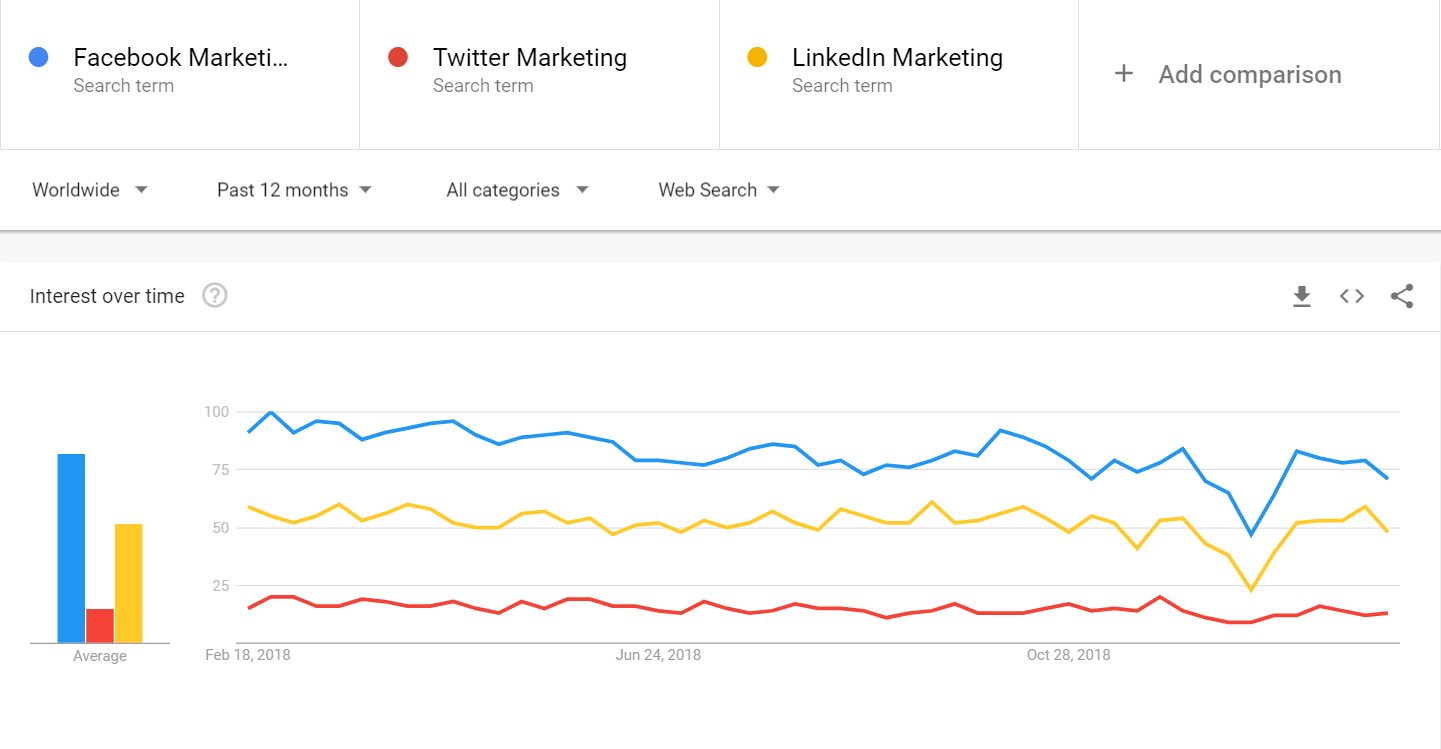
Image Description: A Google Trends analysis of the popularity of Facebook, Twitter and LinkedIn marketing over the past 12 months worldwide. Facebook is the most popular, followed by LinkedIn, then followed by Twitter. (Source: Google Trends)
A word of caution, though: make sure that said competitor actually posts to these profiles and that they’re not graveyard sites. Make sure there’s a balance between regular updates and high follower counts, and don’t just assume that a Facebook page with 90 likes means Facebook is a no-go if there’s nothing to be found about the conference except a sound-bite from 2015.
Don’t just stick to the usual trinity of Facebook, LinkedIn and Twitter, though.
Similarly, to host teasers, promos, and past talks, many conferences have opted to launch YouTube and Vimeo channels in recent times, so it’s worth doing a quick search there too, both for ideas of what sort of videos you could produce for your event, and the popularity of pre-existing channels to see if one of the options might provide you with some good exposure.
2) Paid Social Media
The Takeaway:
- Where your competitors are spending their money and if doing the same is worth your while.
Organic might not be dead, but the teams behind the largest social media sites are doing their utmost to make it attractive for businesses to spend money for exposure. If you want to spend your first few coins on social ads, it’s worthwhile to incorporate research here into your competitive analysis framework, too.
For Facebook
If you’ve already identified your competitors’ Facebook pages, you can simply navigate to their page, and go to the Info & Ads section. From there you’ll be able to see their ads chronologically across different regions. You won’t be able to see the engagement with those ads from this view, but it can give you a good idea of what kinds of content your competitors are advertising. I went with the protein bar company Fulfil Nutrition (admittedly because I had one of their bars on my desk).
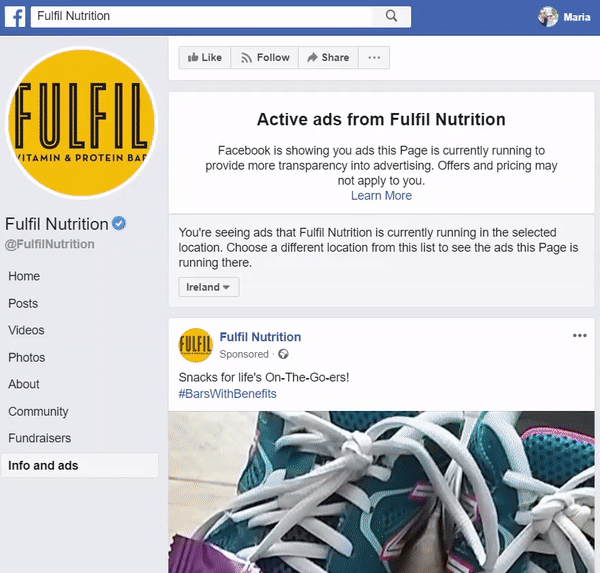
Image Description: A scrolling preview of the Facebook ads running for Fulfil Nutrition showing that the ads are different across different geographies.
For Twitter
Twitter has a dedicated ads transparency centre where you can search for any brand or page’s promoted content. However, unlike Facebook, Twitter only shows data for the last seven days prior to your search. So, if your competitor’s event promotion falls outside this timeframe, you won’t get much insight, but if you’re planning ahead of time, you could set a reminder to check in closer to the date of their event.
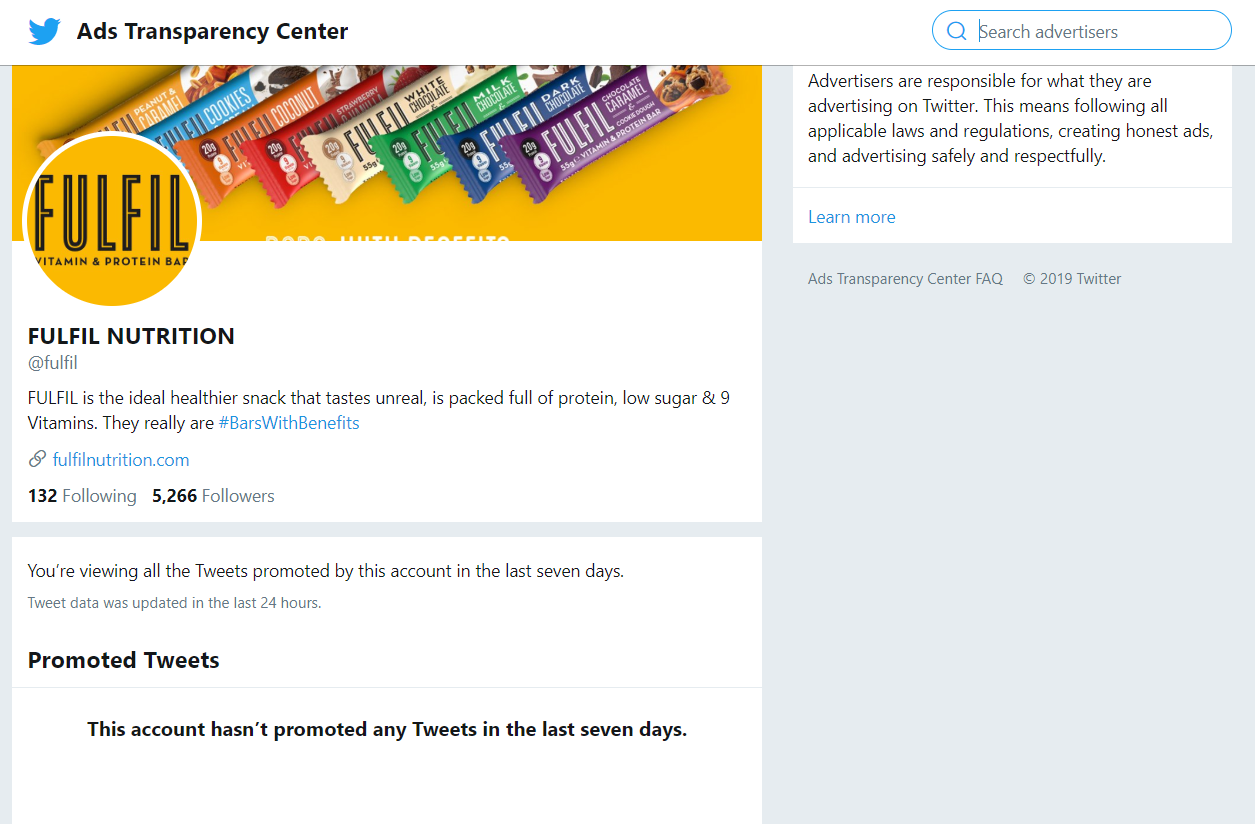
Image Description: A view of the Twitter ads transparency centre searching for Fulfil Nutrition. They have not promoted any tweets in the seven days prior to this search.
For LinkedIn
There’s no quick overview available as yet to check in on your competitors’ LinkedIn ads, but there are some tools you can use to get a general overview of your competitors ads across the web, if you want to go beyond individual social networks, which we’ll cover in the next section.
3) SEM & Display Ads
The Takeaway:
- How to see what your competitors are paying for and if it’s worth you placing a bid.
For SEM
For the simplest way to see what your competitors are paying for in terms of search engine ads, you need only search for the type of event you’re hosting. If, for example, we look at “marketing conference” as a keyword, these are the results I get:
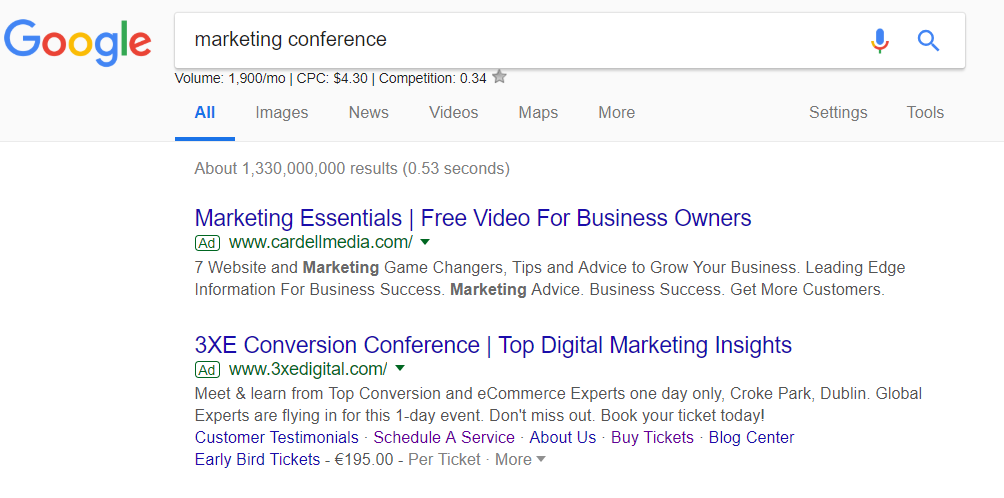
Image Description: A screenshot of Google results for “marketing conference”.
For context, I’m searching from Ireland and I have Keywords Everywhere running on my browser, hence why I can see the cost per click for this keyword ($4.30).
These results show us that 3XE and Cardell Media are bidding on that keyword. One is a conference, and one is an individual’s website. To see whether this would be worth my while, I’d have to dig a little deeper, but from a first glance, it seems like there’s already some relatively expensive competition for this keyword, meaning it might not show a good return on spend if I were to bid on it.
To do analysis on your own competitors, start with your five most relevant keywords to see if your competitors are bidding on them. Then it’s time to see if it’s worth investing yourself.
Furthermore, using a Google Ads account, even without bidding anything, you can do some research to see how much you would need to spend to rank above your competitors for keywords they already appear for via Google searches. You need simply log into your account, and add their URL instead of a keyword in the Keyword Planner tool.
From there you can see the low and high bids on each keyword associated with that site. There are multiple filters you can play around with to find more granular information. Here’s what the interface looks like for apple.com, to give you an idea of what you can expect:
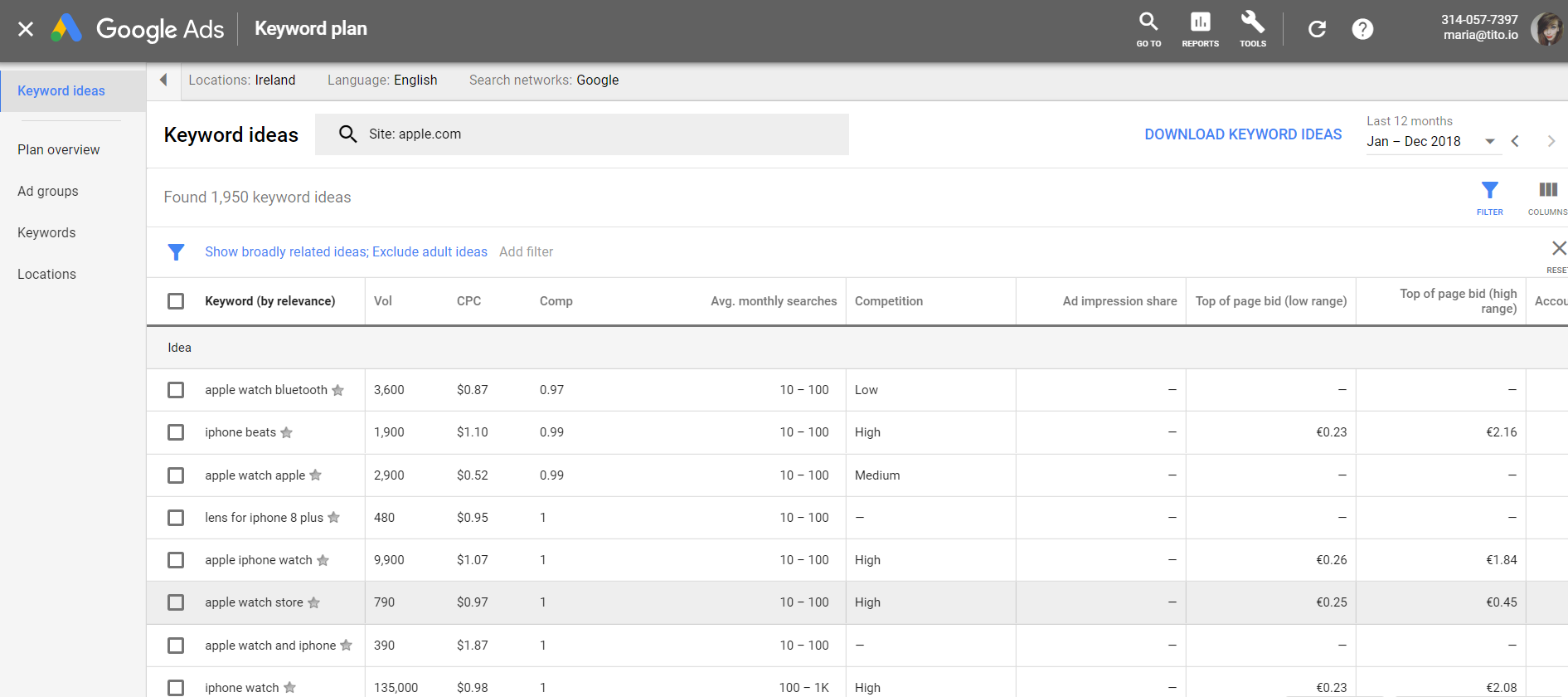
(Click here to enlarge the image)
Image Description: A screenshot of the Keyword ideas tool in the Google AdWords dashboard interface showing the keywords that Apple are currently bidding on.
For Display Ads
Display ads can be a little trickier as you’d need to have them targeted at you to see them, right? Well, no. As per usual, there’s an app for that. Or, a website, to be more precise.
Adbeat gives you info about the ads running for any company once you input their URL. In the example below, you can see native, video and standard ads running for Squarespace, as well as the site’s landing pages and an overview of their ad activity.
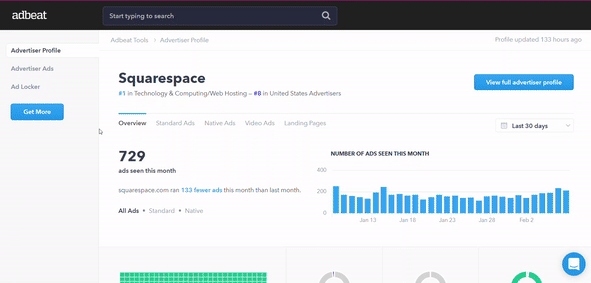
Image Description: A run through of the AdBeat interface showing previews of all of the ads running for Squarespace as well as the time they’ve been running and the ad channels they’re using.
Since you can click into each ad, you can again get inspiration from your competitors by seeing their aesthetic, copy and conversion optimisation practices, as well as the types of campaigns they’re running if paid advertising is something you’re planning on investing in for your event.
4) Content & SEO
The Takeaway:
- Possible ways to get more traffic to your event website.
SEO is one of the longer plays when it comes to building interest in your event, but it can be one of the most cost-effective ways to help people acquainted with your event, even if they’ve never heard of you before.
Therefore, it can be helpful to check your competitors’ strategy when it comes to keywords when undertaking competitor analysis. You can find what their event site is ranking for by using something like SEMRush, SpyFu or Serpstat. These will give you a good indication of what their attendees and, given their your competitors, your attendees are looking for online.
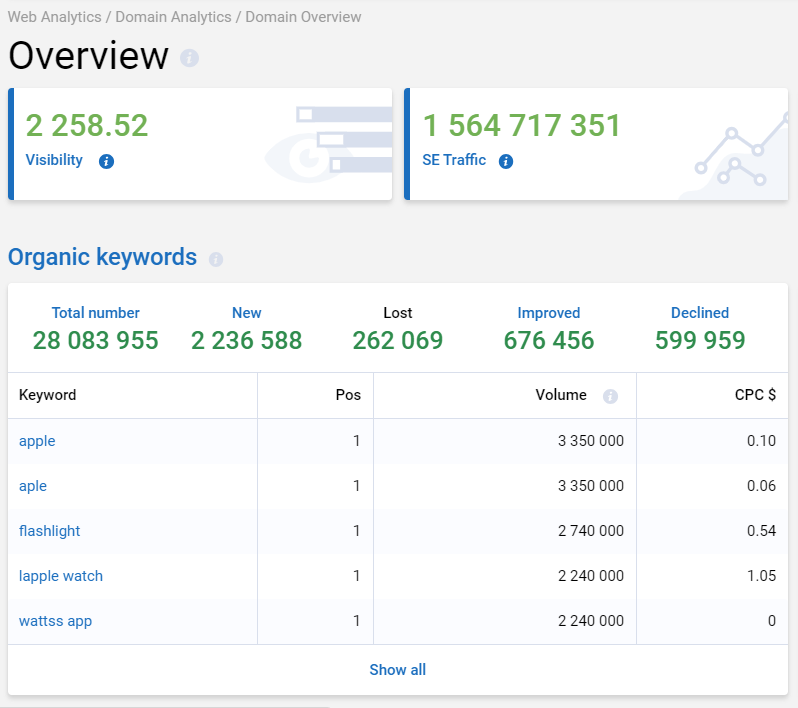
Image Description: A screenshot from SerpStat showing the organic keywords that apple.com is ranking for.
One of the tried-and-true ways to start amping up your ability to rank for keywords is producing helpful content around your knowledge of the topics your event is about, and the goings-on at your event that will help attendees learn more about those topics.
That said, not every demographic is going to want to read the same thing. A more technical audience might be interested in industry reports and highlights. A more creative audience might appreciate information that’s heavily complimented by images.
In any case, you can start your research by checking your competitors site to see if they have a resources section or a blog. If you don’t find anything there, you can try searching for the name of the event or the host company on Medium or checking the organisation’s LinkedIn to see if they publish there. That can help you get a feel of whether or not there’s an appetite for written content among the people who will potentially be attending your events.
One of the challenges that affects every industry is knowing what to write about. After checking what keywords your competitors are working on for their events, you can work on finding long-tail keywords that you can start creating original content about, if you choose to go down that road.
SEMRush provides insights into that, though it can get a little pricey. But you can try free alternatives like Keywords Everywhere to begin. Look for keywords that balance high search traffic with a low competition score to begin with.
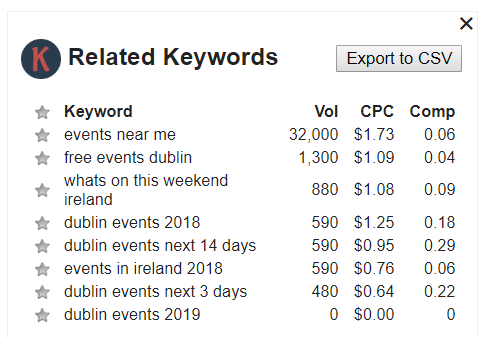
Image Description: A view of Keywords Everywhere running on a Google search. This shows the results for Googling “events” from a Dublin-based IP. The top three results are “events near me”, “free events Dublin” and “whats on this weekend Ireland”.
Thinking further about competitor strategies, many marketers are fans of the “Skyscraper technique“. This technique involves first finding some of your competitors high-ranking articles or pages.
If you’ve ever gone looking online for answers, you’ll know that sometimes a headline can be promising, but the rest of the article or webpage can leave you feeling unsatisfied.
When it comes to your competitors, if you find a resource like that that aims to answer a question for your potential attendees, you can try creating your own piece of content that you think might be more helpful by adding additional information or a different take on the topic.
Once you’ve written some content and added some copy to your event site, you can then work on optimising your pages for on-page keywords. If you’re looking for a way to start optimising your existing event page(s), we’ve written some guidelines on basic on-page SEO for event organsiers.
But, what about off-page SEO? One of the biggest factors the people behind search engines take into consideration when deciding if your website deserves to be first in their results is how many sites link back to it. This kind of linking signals that other outlets thought their readers would also get benefit from what you’ve written.
If you’re hoping to build more backlinks, a good way to find sites that write about or reference events like yours is to run a backlink analysis on one or more of your competitors’ sites. This will give you a list of places across the web where their articles or pages have been linked.
You can then reach out to any sites you think could get use from your messaging or event details safe in the knowledge that they’ve covered something similar before. Monitor Backlinks provides a free tool to get you started.
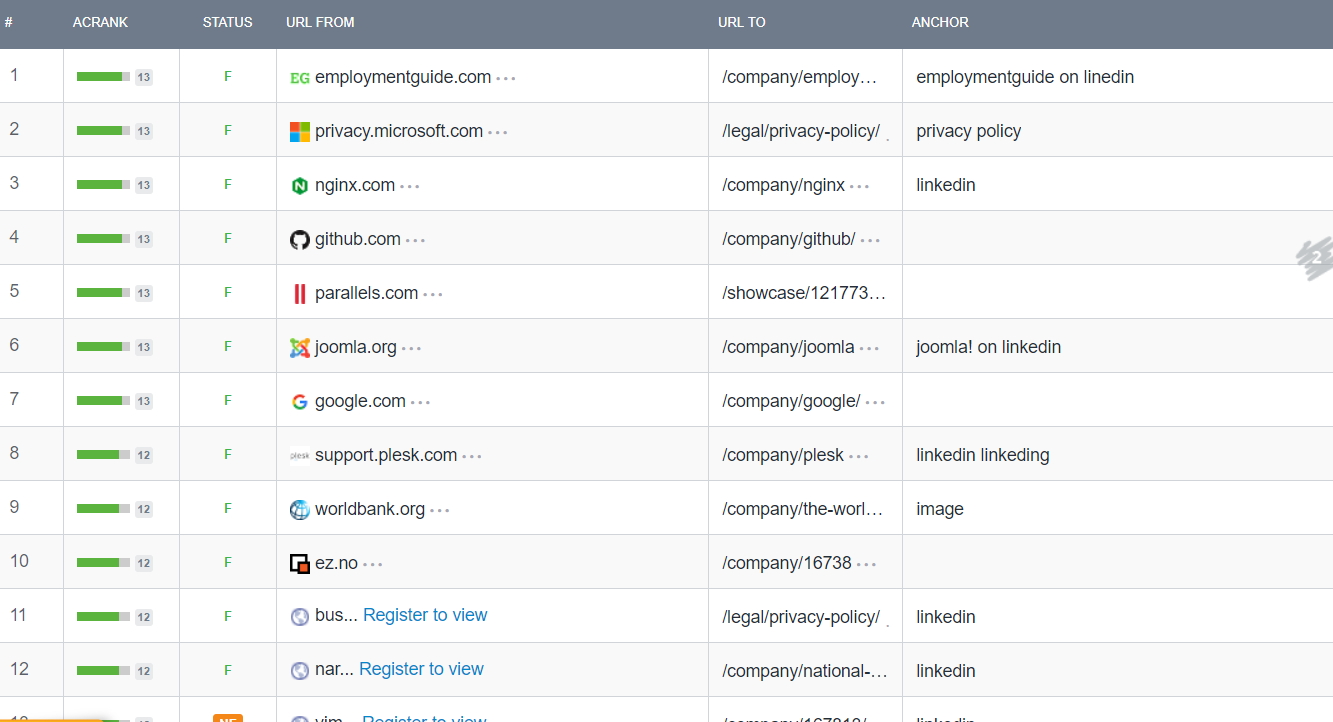
Image Description: Backlink analysis screenshot of linkedin.com from Monitor Backlinks.
If you also want to keep an eye on where your competitors are being mentioned in the news, you can set up a Google Alert for their brand name. You’ll then receive an email round up of mentions at a frequency you choose. It’s not a bad idea to also do this for your own brand in case any coverage slips through the cracks.
5) Community Building
The Takeaway:
- Options to help build an engaged audience.
As well as looking into their social media, a lot of conference and event organisers use private communities and tailored marketing messages to keep past attendees and “warm leads” engaged with their brand and offerings.
Oftentimes, event pages will link to private Slack channels, newsletters, and even dedicated forums hosted on-site where past audiences and members of the community the conference caters to will gather to talk shop.
A lot of people will know their competitors from a mile away, so there’s a strong chance that you won’t be able to find your way into that Slack channel to check out its activity.
However, signing up to a competitor’s newsletter can give you insight into what types of content and offers they’re providing, as well as how often they’re sending updates. That way, you can get inspired or, if you don’t like their style, figure out an alternative way to communicate that might resonate better with your attendees.
Sales
6) Web Technologies
The Takeaway:
- How different tools could help you take some of the pressure off.
The many demands of organising a conference or event mean that those in charge of them often look to tools to automate or otherwise handle some of the tasks. That said, there’s a helluva lot of options out there for organisers. Cramer put together this illustration of the 2019 event technology landscape and, well, let’s just say there’s something for every taste:
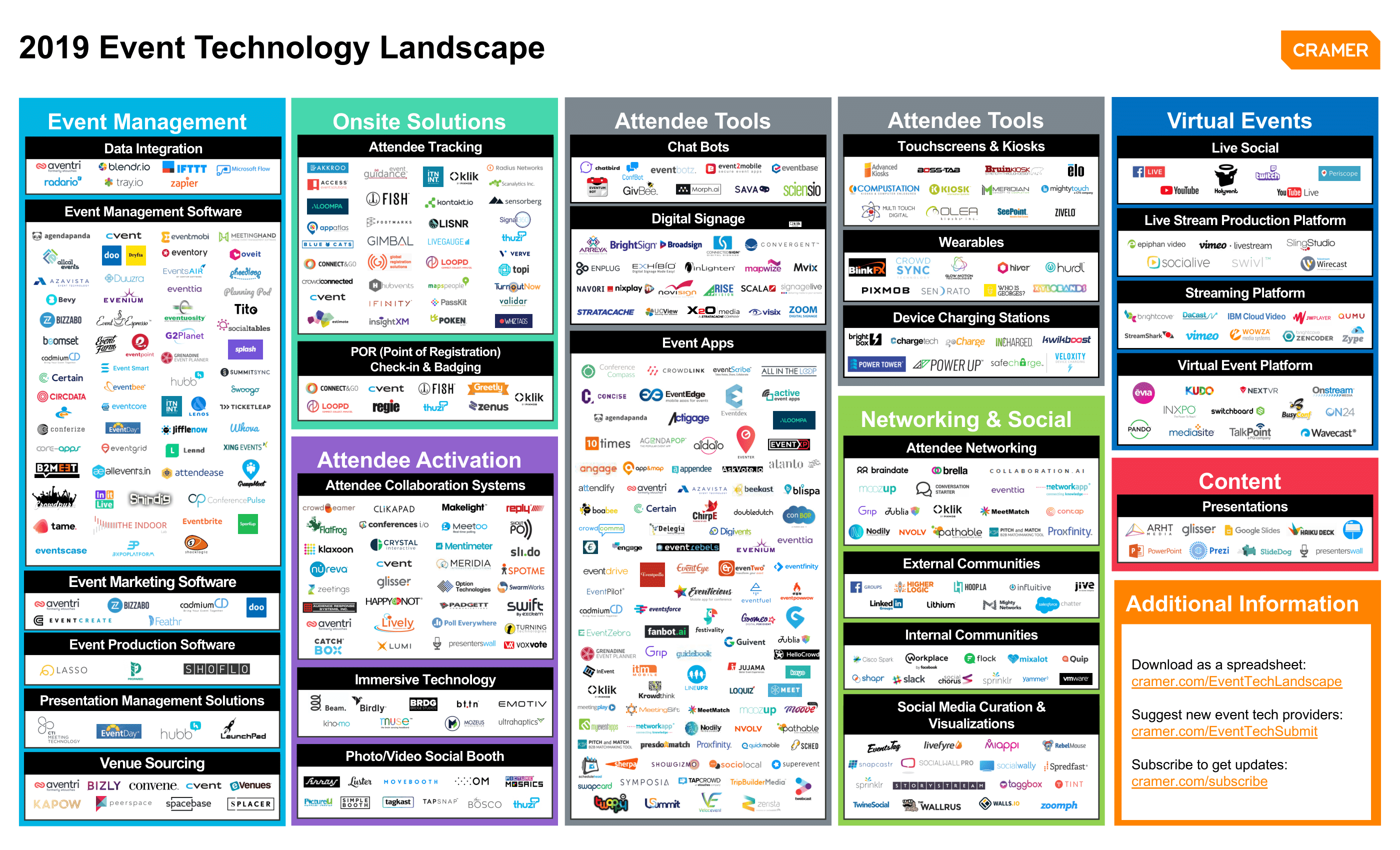
However, if you particularly enjoyed part of the flow on your competitor’s event website, it could be worth your while looking into what tools they’re using to see if adding any to your own set up could be of use.
Datanyze is a tool that can help you find those tools. Meta, yes, but as part of its Chrome Extension capabilities, Datanyze shows you a list of web technologies running on any website you visit. You might want to run it over a particularly strong connection though, as it does tend to cannibalise bandwidth.
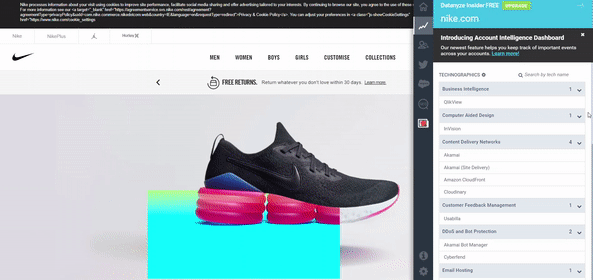
(Click here to enlarge the image)
Image Description: A scroll-through of the different technologies running on nike.com by using Datanyze. It shows the different categories of tool in a sidebar.
Of course, your competitors might well be using additional tools on the day of their event for tasks then, but this can help you get a feel for what the competition are using in the build-up and throughout their planning process.
7) Tickets
The Takeaways:
- What attendees expect to pay for an event like yours.
- What types of ticket offers work for your industry.
At Tito, we think a lot about tickets and how best to help organisers sell them. When it comes to your competitors, you can get a lot of industry-specific knowledge simply by looking at their ticket pages as part of your competitive analysis framework.
When it comes to ticket pricing, it could be worth your time taking a sample of four or five competitors to see how much their charging attendees. As well as calculating how much you’ll need to charge to cover the expenses associated with hosting, this will give you a ballpark of what you can realistically charge per ticket.
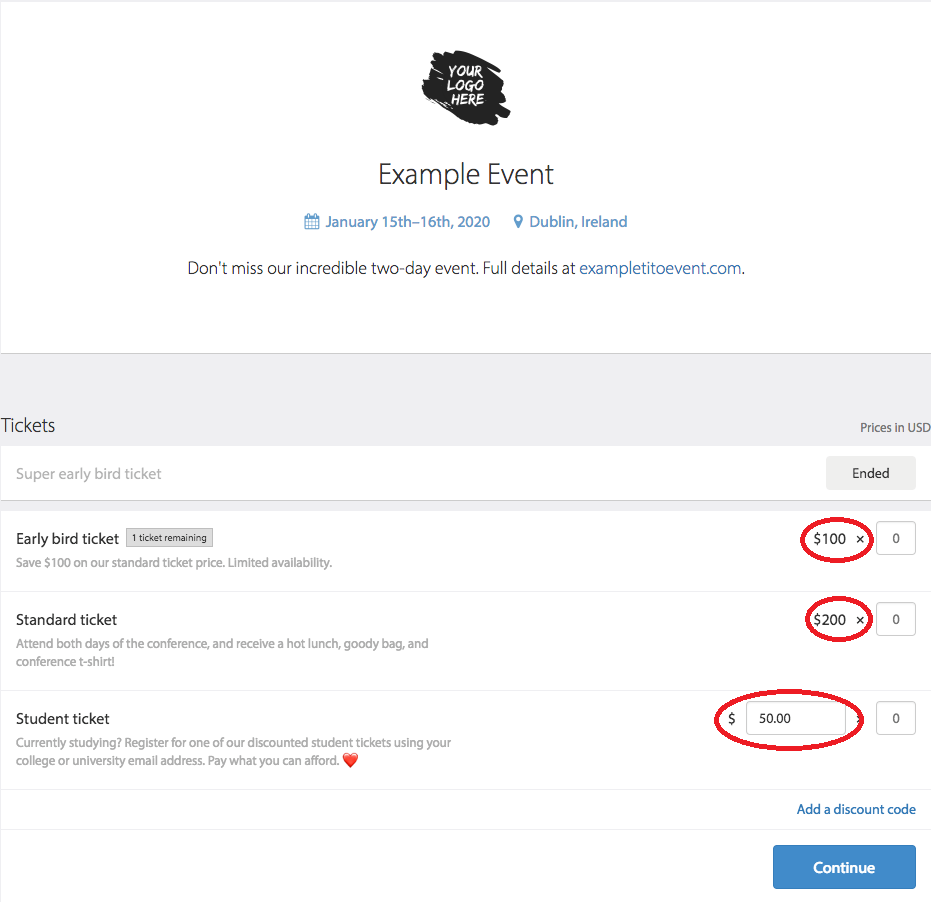
Image Description: A screenshot of a demo event page in Tito highlighting different ticket prices.
When doing this research, it’s important to take the duration of the event and tracks into account. Conferences that have “big ticket” speakers like celebrities delivering keynotes will inevitably cost more due to the costs incurred in their speaking fee.
Further to that, events that run three concurrent tracks will have more expenses (and larger price tags) associated as they’re essentially tripling the number of speakers and other cost-incurring factors that a single-track conference wouldn’t have. Ditto if your competitor is running a multi-day conference and you’re running a single day, or vice-versa.
Then you’ll want to think about ticket types. Do your competitors run super early bird offers? What about buy-one-get-one-free promotions? Are they offering scholarship programs for under-represented individuals?
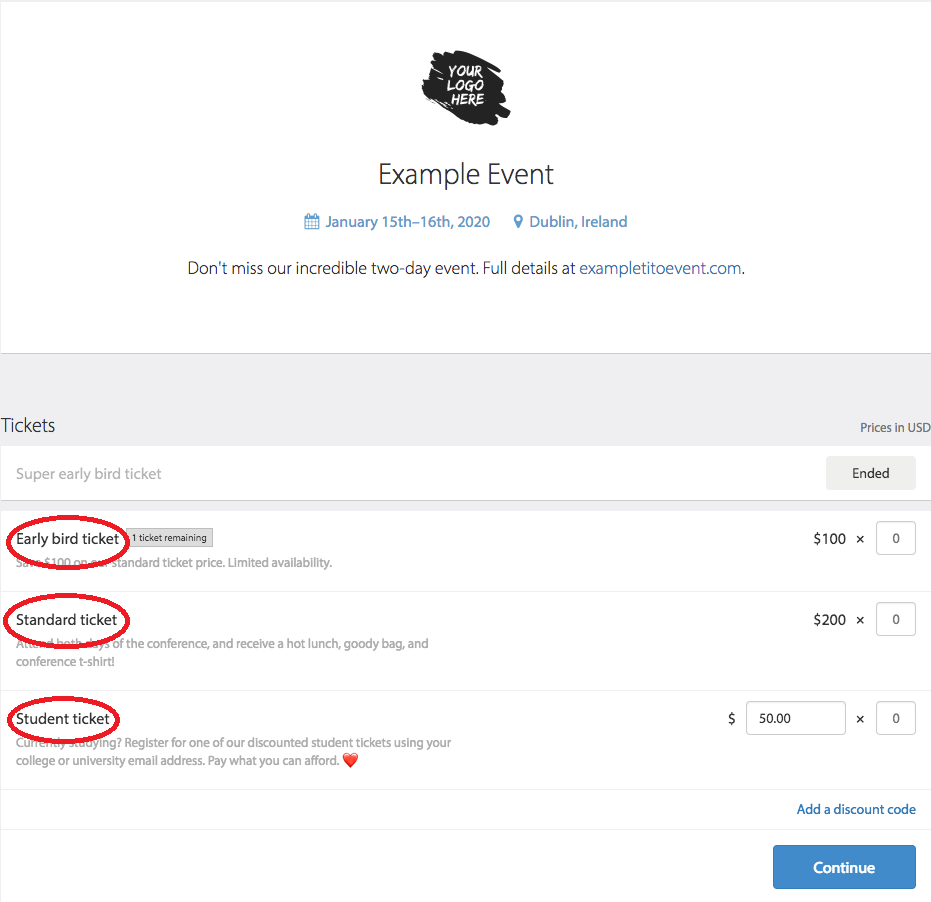
Image Description: A screenshot of a demo event page using Tito highlighting different ticket types (early bird tickets, standard tickets, and student tickets).
All of these options will affect how your tickets sell and how you can project ticket sales. As well as encouraging people to commit to attending your event early, thus helping with cash flow, you can also use methods like this to amp up attendance generally and give back to the community.
8) How are they gathering leads?
The Takeaway:
- Different approaches to getting to know who’s visiting your site, even if they’re not ready to buy yet.
As someone “in the biz”, you’ll be aware of the fact that there are multiple ways to set up your conference page, and yet more to set up your lead flows. There are a few questions you should consider when looking at your competitors’ sites and the bells and whistles you could add to your own.
1. Are they using chat bots? Chat bots are an emerging avenue for success when it comes to engaging traffic visiting event websites and beyond. Many suppliers provide the ability to have qualification questions set up to gather information about site visitors who want more information, but who don’t want to buy their tickets just yet. For example, Intercom Messenger (pictured below). Salesforce, interestingly, says that 69% of consumers prefer interacting with chatbots when communicating with brands for quick answers (say, for example, when tickets go on sale).
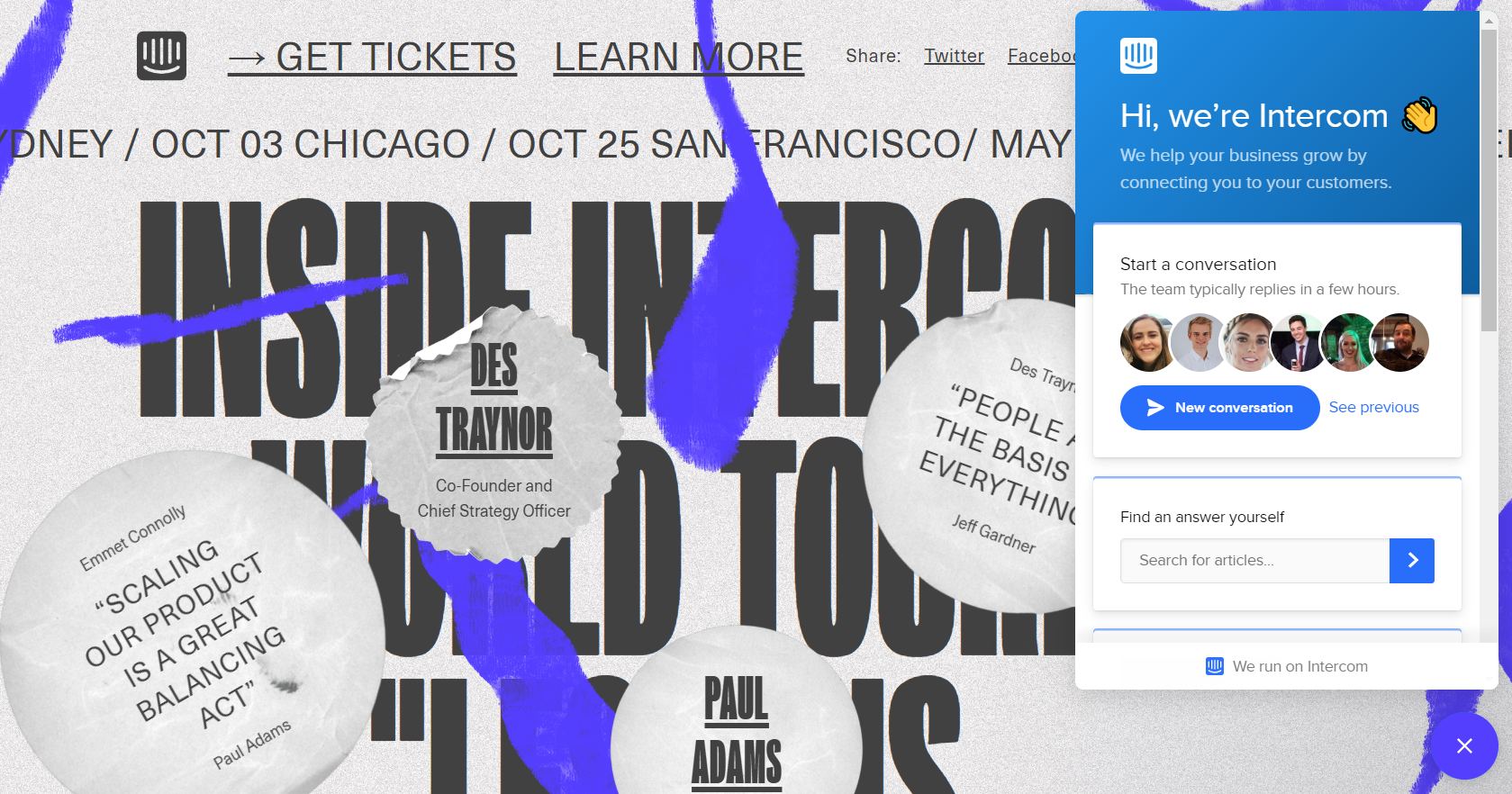
Image Description: A screengrab of the Inside Intercom event series which has the Intercom Messenger feature running on the site.
2. Are there forms on their site? Take them with a generous pinch of salt, but exit intent pop-ups and dwell-time pop-ups are other options you could explore to gather lead info. Personally, I find them a nuisance, so consider your potential attendees’ preferences when you’re mulling it over.
Of course, a lot of organisers also use static forms to get the job done. The option I’ll favour in this post to help stay in touch with potential attendees (to the point where Tito have built a tool for it) is to set up an ‘interested people’ option. That lets you gather information without being intrusive.
9) Sponsorship
The Takeaway:
- How your competitors are attracting sponsors.
Sponsors
While it might seem counter-intuitive to go looking for money that’s already spent, we’ve done some research before to suggest that sponsors are often happy to put their cash behind multiple conferences and events that cater to the audience they’re trying to put themselves in front of.
Usually sponsors will be listed on event pages, so it could be worth your while to create a list of the businesses you come across when creating a long- or shortlist of who you’ll be reaching out to when the time comes.
If you’re in the developer or design space, we’ve put together these two resources to save you time:
Sponsorship Prospectuses
To compliment the point above, it’s also a good idea to look into what proposals won the attention of your competitors’ sponsors. Try taking a look at the headings, data, presentation style, and brevity (or length) of their proposal documents. A lot of events will have their prospectuses live on their site. However, you can also try searching online for them by including .pdf in your queries to see if they’re available on a separate domain.
In Conclusion
Of course, we could never hope to cover everything you could hope to learn about your competitors in a single post, but hopefully you’ve garnered some food for thought to help you bolster sales and marketing strategies for your events.
To stay up to date with other post we’ll be publishing about selling and marketing your events, you can subscribe for updates here: